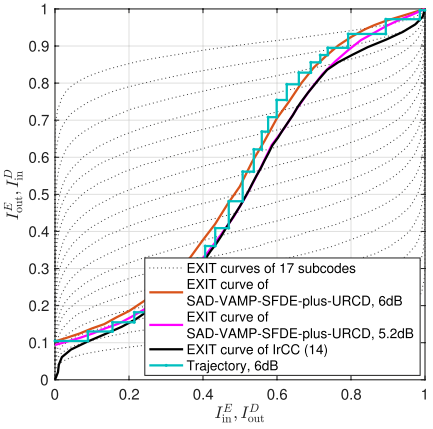
For communication systems, the propagation of signals from the transmitter to the receiver via multiple paths is called multipath effect, leading to the overlap of multiple sequentially-transmitted symbols at the receiver. The phenomenon causes inter-symbol interference (ISI) at the receiver, which makes it difficult for communication signal detection and symbol recovery.
In order to combat the ISI and approach the channel capacity, researchers from the Institute of Acoustics (IOA) of the Chinese Academy of Sciences along with Prof. TAO Jun from Southeast University proposed an approximate message passing (AMP)-based near-capacity method which could significantly narrow the performance gap from the severe channel capacity. The study was published in IEEE Access.
Turbo equalization is a well-known receiver technique for combating the ISI. It generally consists of a soft equalizer and a soft decoder, which iteratively exchange extrinsic information to improve the detection performance.
Typical turbo equalization schemes generally adopt a fixed convolutional code, a turbo code or a low density parity check code, which does not properly match the channel as the channel code, and choose the suboptimal minimum mean square error (MMSE)-optimized linear equalizers and decision feedback-type equalizers. In summary, this turbo receiver has a large gap to the channel capacity.
Aiming at the soft equalizer, researchers proposed a semi-adaptive damping (SAD)-aided vector AMP (VAMP) soft frequency-domain equalizer (SFDE). It completely eliminates the ISI based on some a priori information over the low signal-to-noise ratio (SNR) region employing the fast Fourier transform with the quasi-linear computational complexity. Afterwards, researchers designed and further optimized the inner and outer codes based on the extrinsic information transfer (EXIT) curve of the SAD-VAMP-SFDE.
The inner code introduced the unity-rate code (URC) to eliminate the error floor of iterative decoding. The outer code was designed as an irregular convolutional code (IrCC) which matched the EXIT curve of the concatenated URC decoder and the SAD-VAMP-SFDE via a weight combination of multiple subcodes. It effectively lowered the iterative SNR-threshold. Finally, a three-fold iterative processing among the SAD-VAMP-SFDE, the URC decoder, and the IrCC decoder was achieved.
Simulation results showed that under the 6-path minimum-distance severe channel, the SNR gap of the proposed system with the SAD-VAMP-SFDE was only 1.3 dB from the approximate uniform input capacity.

Figure 1. Block diagram of proposed near-capacity transceiver system. (Image by IOA)


Figure 2. EXIT chart (left) and bit error rate performance curves (right) of the three-fold iterative receiver. (Image by IOA)
In the following study, researchers would apply this method to underwater acoustic communication (UAC) systems to improve its communication rate and performance as well as reducing power consumption.
This research was supported by the National Natural Science Foundation of China, and the National Key Research and Development Program of China.

86-10-68597521 (day)
86-10-68597289 (night)

86-10-68511095 (day)
86-10-68512458 (night)

cas_en@cas.cn

52 Sanlihe Rd., Xicheng District,
Beijing, China (100864)

